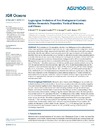Identificador persistente para citar o vincular este elemento:
https://accedacris.ulpgc.es/handle/10553/70116
| Campo DC | Valor | idioma |
|---|---|---|
| dc.contributor.author | Morris, T. | en_US |
| dc.contributor.author | Aguiar González, Miguel Borja | en_US |
| dc.contributor.author | Ansorge, I. | en_US |
| dc.contributor.author | Hermes, J. | en_US |
| dc.date.accessioned | 2020-02-05T12:52:30Z | - |
| dc.date.available | 2020-02-05T12:52:30Z | - |
| dc.date.issued | 2019 | en_US |
| dc.identifier.issn | 2169-9275 | en_US |
| dc.identifier.other | Scopus | - |
| dc.identifier.uri | https://accedacris.ulpgc.es/handle/10553/70116 | - |
| dc.description.abstract | We investigate the 3-D Lagrangian evolution of two Madagascar cyclonic eddies based on ad hoc Argo experiments undertaken in April and July 2013. Eight Argo floats were configured to measure temperature and salinity at high temporal resolutions (daily and five-daily experiments) and varying park depths (300, 500, 650, and 1,000 m) to test their performance with regard to retention within the eddies described. Near-surface eddy properties are derived from an eddy detection and tracking algorithm applied to satellite altimetry data and a quasi eddy-resolving (1/4°) ocean general circulation model (GLORYS2v4). Both eddies propagated southwestward from southwest Madagascar (26°S, 40°E), where the South East Madagascar Current separates from the continental shelf. During a travel of about 130 days at an average speed of 11 km day−1, the eddies experienced well-defined growth, mature, and decay phases, interacting with the Agulhas Current at the KwaZulu-Natal Bight (28°S, 34°E). Model-based estimates indicate the April (July) eddy showed mean trapping water depths of 595 ± 294 m (914 m ± 107 m), volume transport about 13.4 ± 5.2 Sv (21.2 ± 9.1 Sv), heat flux of −0.07 ± 0.06 PW (-0.2 ± 0.09 PW), and freshwater flux of 0.04 ± 0.04 Sv (0.09 ± 0.05 Sv). Peak estimates were found for both eddies during the mature eddy phase. These results highlight the role of Madagascar cyclonic eddies as transporters of cooled and freshened source waters into the Agulhas Current and illustrate the benefits of ad hoc Argo configurations for the study of 3-D Lagrangian eddy dynamics in combination with a “state-of-the-art” ocean model and remotely sensed data. | en_US |
| dc.language | eng | en_US |
| dc.relation.ispartof | Journal of geophysical research. Oceans | en_US |
| dc.source | Journal of Geophysical Research: Oceans [ISSN 2169-9275], v. 124 (11), p. 8193-8218 | en_US |
| dc.subject | 251007 Oceanografía física | en_US |
| dc.subject.other | Madagascar cyclonic eddies | en_US |
| dc.subject.other | 3-D Lagrangian evolution | en_US |
| dc.title | Lagrangian Evolution of Two Madagascar Cyclonic Eddies: Geometric Properties, Vertical Structure, and Fluxes | en_US |
| dc.type | info:eu-repo/semantics/Article | en_US |
| dc.type | Article | en_US |
| dc.identifier.doi | 10.1029/2019JC015090 | |
| dc.identifier.scopus | 85075420086 | - |
| dc.identifier.isi | 000497890800001 | |
| dc.contributor.authorscopusid | 16039702000 | - |
| dc.contributor.authorscopusid | 37461138000 | - |
| dc.contributor.authorscopusid | 6701706932 | - |
| dc.contributor.authorscopusid | 7003264533 | - |
| dc.description.lastpage | 8218 | - |
| dc.identifier.issue | 11 | - |
| dc.description.firstpage | 8193 | - |
| dc.relation.volume | 124 | - |
| dc.investigacion | Ciencias | en_US |
| dc.type2 | Artículo | en_US |
| dc.contributor.daisngid | 3861947 | |
| dc.contributor.daisngid | 3617045 | |
| dc.contributor.daisngid | 447353 | |
| dc.contributor.daisngid | 2853608 | |
| dc.utils.revision | Sí | en_US |
| dc.contributor.wosstandard | WOS:Morris, T | |
| dc.contributor.wosstandard | WOS:Aguiar-Gonzalez, B | |
| dc.contributor.wosstandard | WOS:Ansorge, I | |
| dc.contributor.wosstandard | WOS:Hermes, J | |
| dc.date.coverdate | Noviembre 2019 | |
| dc.identifier.ulpgc | Sí | es |
| dc.description.jcr | 3,235 | |
| dc.description.jcrq | Q1 | |
| item.fulltext | Con texto completo | - |
| item.grantfulltext | open | - |
| crisitem.author.dept | GIR ECOAQUA: Ecofisiología de Organismos Marinos | - |
| crisitem.author.dept | IU de Investigación en Acuicultura Sostenible y Ec | - |
| crisitem.author.dept | Departamento de Física | - |
| crisitem.author.orcid | 0000-0002-2064-1724 | - |
| crisitem.author.parentorg | IU de Investigación en Acuicultura Sostenible y Ec | - |
| crisitem.author.fullName | Aguiar González, Miguel Borja | - |
| Colección: | Artículos | |
Citas SCOPUSTM
4
actualizado el 08-jun-2025
Citas de WEB OF SCIENCETM
Citations
4
actualizado el 08-jun-2025
Visitas
94
actualizado el 02-mar-2024
Descargas
166
actualizado el 02-mar-2024
Google ScholarTM
Verifica
Altmetric
Comparte
Exporta metadatos
Los elementos en ULPGC accedaCRIS están protegidos por derechos de autor con todos los derechos reservados, a menos que se indique lo contrario.
